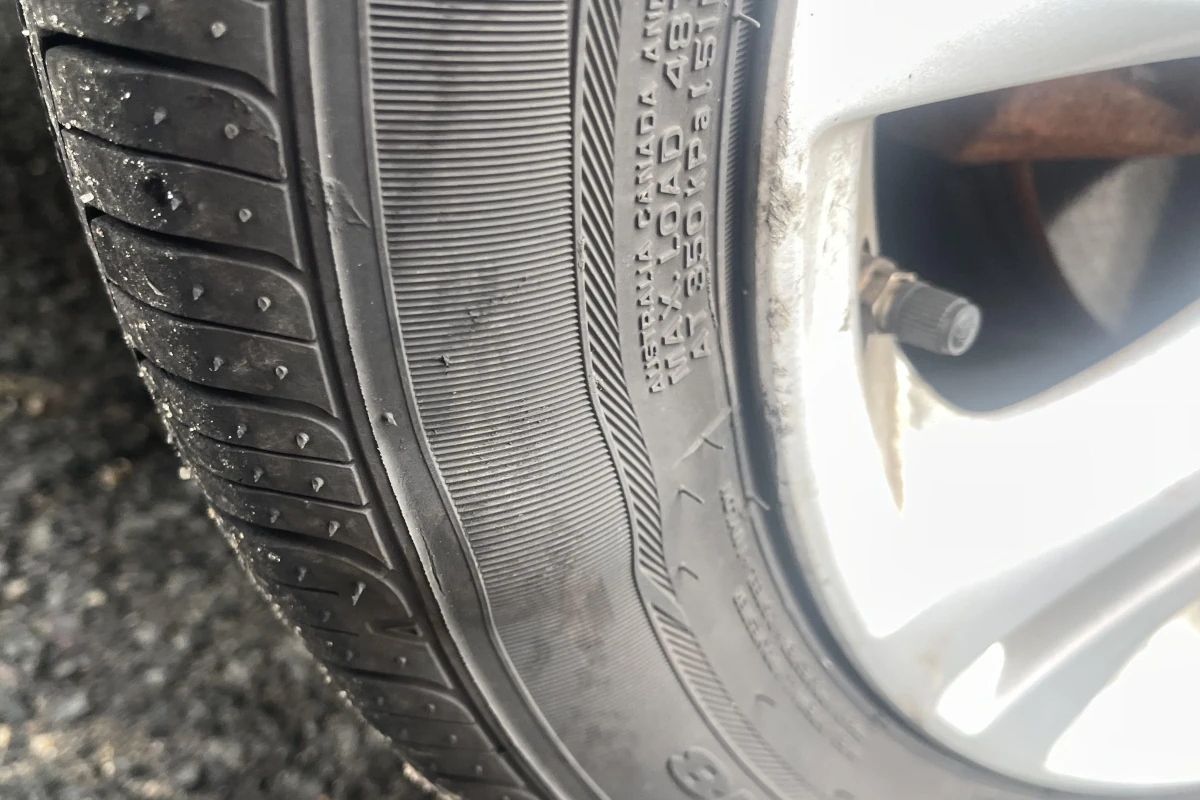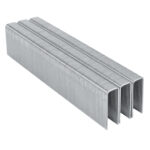Tire sidewall bulges can be a serious safety concern for drivers. These bulges often indicate internal damage to the tire’s structure. A tire with a sidewall bulge should always be replaced immediately to prevent potential blowouts and accidents. This is a very serious issue that should never be ignored and it signals a compromised tire structure that could lead to a dangerous blowout.
Driving on a tire with a sidewall bulge is dangerous. It can lead to loss of vehicle control or a sudden tire failure. This puts the driver and others on the road at risk. Many regions consider tires with visible bulges or separation illegal for road use.
Regular tire checks can help spot sidewall issues early. Look for any unusual bumps or protrusions on the tire’s side. If you notice a bulge pay close attention to its size and location. Even small bulges can signal bigger problems inside the tire. Don’t ignore these warning signs.
Tire Sidewall Bulge Safety
What is a Tire Sidewall Bulge?
A tire sidewall bulge is a bump or bubble that appears on the sidewall of a tire. It indicates that the tire’s internal structure is damaged. This damage can be caused by impacts with potholes, curbs, or other road hazards. It can also result from improper tire inflation or overloading.
Dangers of Driving with a Bulge
Driving with a tire sidewall bulge is extremely dangerous. The bulge weakens the tire significantly. This makes it more susceptible to a blowout at high speeds. A tire blowout can lead to loss of control and a serious accident.
When to Replace a Tire
A tire with a sidewall bulge should be replaced immediately. Do not drive on a tire with a bulge, even for short distances. It’s best to have the tire replaced by a qualified tire professional. They can ensure the new tire is properly installed and balanced.
Tire Sidewall Bulge Table
| Condition | Risk Level | Action |
|---|---|---|
| Small bulge | Moderate | Replace tire soon |
| Large bulge | High | Replace tire immediately |
| Any bulge with visible cords | Extremely High | Do not drive; replace tire immediately |
Tire Warranty
Some tire manufacturers offer warranties that may cover sidewall bulge damage. Check your tire’s warranty information to see if you’re eligible for a replacement or discount. Michelin, for example, is known for its generous warranty coverage, including road hazard protection.
Checking for Warranty Coverage
- Locate your tire’s DOT number: This is a series of numbers and letters embossed on the tire sidewall.
- Contact the tire manufacturer or retailer: Provide them with the DOT number and information about the damage.
- Inquire about warranty coverage: They will be able to tell you if the damage is covered and what steps to take for a replacement.
Avoiding Sidewall Bulges
- Proper tire inflation: Maintain the recommended tire pressure for your vehicle. Underinflation can increase the risk of sidewall damage.
- Careful driving: Avoid hitting potholes, curbs, and other road hazards.
- Load management: Don’t overload your vehicle beyond its recommended weight capacity.
- Regular tire inspections: Check your tires regularly for any signs of damage, including bulges, cuts, or uneven wear.
Key Takeaways
- Sidewall bulges require immediate tire replacement
- Driving on bulged tires risks accidents and is often illegal
- Regular tire inspections help catch sidewall issues early
Understanding Tire Sidewall Bulges
Tire sidewall bulges are serious problems that need quick action. They can harm your car’s safety and handling. Let’s look at what causes them, why they’re risky, and how to spot them.
Causes of Tire Bulge
Tire sidewall bulges often come from hitting things on the road. Potholes and speed bumps can damage tires. Sharp objects can also pierce the tire’s side.
Overloading a car puts too much stress on tires. This can make them bulge. Not enough air in tires (underinflation) is another cause. It makes tires flex too much.
Sometimes tires have flaws from the factory. These weak spots can turn into bulges later. Old tires are more likely to get bulges too. Their rubber gets weaker over time.
Risks of a Bulged Tire
Driving on a bulged tire is very dangerous. The tire could blow out at any time. This can make you lose control of your car.
A bulge means the tire’s structure is weak. It can’t handle the stress of driving well. The tire might fail when you’re going fast or turning.
Bulges can also throw off your car’s balance. This makes steering harder. Your car might not stop as well either.
It’s never safe to keep driving on a bulged tire. You should replace it right away.
Diagnosing a Tire Sidewall Bulge
Check your tires often to catch bulges early. Look for odd bumps or bubbles on the side of the tire. These are signs of a bulge.
Run your hand over the tire’s side. Feel for any spots that stick out. A healthy tire should be smooth all around.
Use a tire gauge to check air pressure. Low pressure can lead to bulges. Make sure all tires have the right amount of air.
Look closely at the tire’s tread too. Sometimes bulges show up there. Any odd shapes in the tread are bad signs.
If you’re not sure, ask a pro. Tire shops can do full inspections. They have tools to check for hidden damage inside tires.
Proper Tire Maintenance and Replacement
Regular tire care is vital for safety and performance. Proper maintenance can extend tire life and help avoid dangerous situations on the road.
Maintaining Your Tires
Check tire pressure monthly using a tire gauge. Keep tires at the correct pressure listed in your car’s manual. Under-inflated tires wear faster and can lead to blowouts.
Rotate tires every 5,000-8,000 miles. This helps them wear evenly. Check tread depth regularly with a penny test. Insert a penny upside down into the tread. If you can see Lincoln’s head, it’s time for new tires.
Avoid road hazards when possible. Potholes and curbs can damage tire sidewalls. Don’t overload your vehicle. Too much weight strains tires and can cause bulges.
Clean tires with soap and water. Remove rocks or debris stuck in the treads. Store spare tires properly to prevent dry rot.
When to Replace a Tire
Replace tires when the tread depth reaches 2/32 inch. Most tires have built-in tread wear bars to show when it’s time. Uneven wear may mean you need an alignment.
Tire age is also key. Many experts say to replace tires after 6-10 years even if tread looks good. Check the date code on the sidewall.
Replace tires right away if you see:
• Bulges or blisters on the sidewall
• Cracks or cuts in the sidewall
• Exposed cords or fabric
• Vibration or thumping when driving
Never try to repair a tire with sidewall damage. It’s not safe and could lead to a blowout. Always replace damaged tires promptly.
Frequently Asked Questions
Tire sidewall bulges pose serious safety risks. Proper management and replacement are crucial. Understanding the causes and symptoms can help prevent dangerous situations.
What are the dangers of driving with a sidewall bulge in a tire?
Driving with a sidewall bulge is extremely unsafe. The tire could burst at any moment. This may lead to a sudden loss of control. It could cause a serious accident.
How should a tire with a sidewall bubble be managed?
Do not drive on a tire with a sidewall bubble. Replace the tire immediately. Attempting to repair the bulge is not a safe solution. The internal damage cannot be fixed from the outside.
What are the common causes of a sidewall bulge in tires?
Sidewall bulges often result from impact damage. Hitting potholes or curbs can cause them. Overloading the vehicle may also lead to bulges. Improper tire inflation is another common cause.
When should a tire with sidewall damage be replaced?
Replace a tire with sidewall damage right away. This includes cuts, punctures, or bulges. Do not wait or try to repair it. The tire’s structure is compromised and unsafe.
What are the symptoms indicating the presence of a bubble in the tire?
Look for visible bulges or blisters on the tire’s sidewall. You may feel vibrations while driving. Uneven tire wear can also be a sign. Regular tire inspections help catch these issues early.
Does tire warranty typically cover sidewall bulges?
Most tire warranties do not cover sidewall bulges. They are usually considered impact damage. This type of damage is not a manufacturing defect. Check your specific warranty terms for details.




